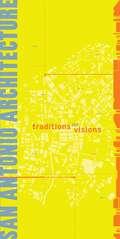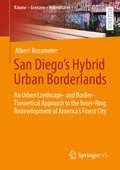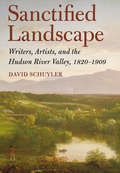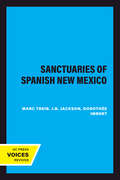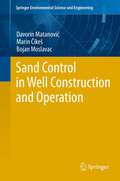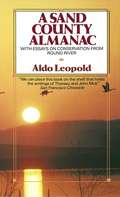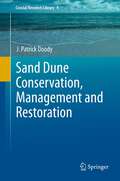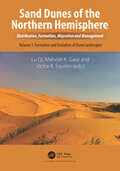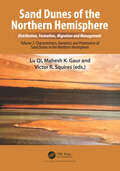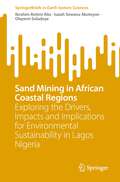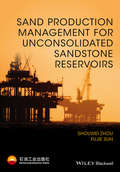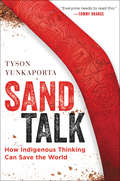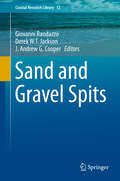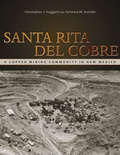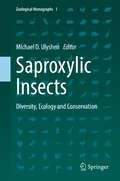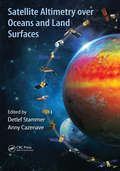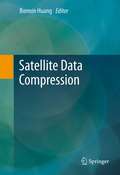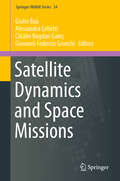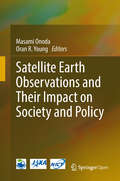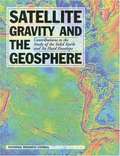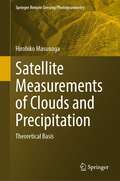- Table View
- List View
San Antonio Architecture
by San Antonio Boone PowellWith a history more than 290 years old, San Antonio boasts a diverse, eclectic, and important architectural inventory. From the Spanish Missions of the 17th century to invigorating adaptation and restoration of historic buildings alongside landmark new construction, there is a wide array of culturally significant assets reflecting Anglo and Hispanic traditions, alongside regional variations of southern and southwestern American styles.San Antonio Architecture is the comprehensive catalog of the architecture inventory of the city. Complete with color illustrations, keyed maps, and informative essays, it is a must-have book for every armchair and on foot architectural, art, and community historian.
San Diego's Hybrid Urban Borderlands: An Urban Landscape- and Border-Theoretical Approach to the Inner-Ring Redevelopment of America’s Finest City (Räume – Grenzen – Hybriditäten)
by Albert RossmeierThis study aims for a wider understanding of the redevelopment processes that emerged several decades ago in downtown San Diego and now gradually spread over the downtown edges into the inner ring. Perspectively situated in the fields of urban landscape and urban border studies, the research project outlines how the eastward ‘redevelopment wave’ in San Diego contests socialized neighborhood (boundary) perceptions by transforming the former first-tier suburbs from disinvested communities into ‘urban villages’ and trendy places to be. The study shows how the redevelopment perforates, dissolves, and shifts socialized, linear neighborhood boundaries into areas that are simultaneously part of the one and the other neighborhood. In the present work, the resulting, rather undefined or stretched border areas have been referred to as hybrid urban borderlands. This notion is a novel conceptual approach that can be deemed a promising lens for future studies on neighborhood change, urban redevelopment, and socio-spatial re-interpretation beyond the context of San Diego.
Sanctified Landscape: Writers, Artists, and the Hudson River Valley, 1820–1909
by David SchuylerThe Hudson River Valley was the first iconic American landscape. Beginning as early as the 1820s, artists and writers found new ways of thinking about the human relationship with the natural world along the Hudson. Here, amid the most dramatic river and mountain scenery in the eastern United States, Washington Irving and James Fenimore Cooper created a distinctly American literature, grounded in folklore and history, that contributed to the emergence of a sense of place in the valley. Painters, led by Thomas Cole, founded the Hudson River School, widely recognized as the first truly national style of art. As the century advanced and as landscape and history became increasingly intertwined in the national consciousness, an aesthetic identity took shape in the region through literature, art, memory, and folklore-even gardens and domestic architecture. In Sanctified Landscape, David Schuyler recounts this story of America's idealization of the Hudson Valley during the nineteenth and early twentieth centuries. Schuyler's story unfolds during a time of great change in American history. At the very moment when artists and writers were exploring the aesthetic potential of the Hudson Valley, the transportation revolution and the rise of industrial capitalism were transforming the region. The first generation of American tourists traveled from New York City to Cozzens Hotel and the Catskill Mountain House in search of the picturesque. Those who could afford to live some distance from jobs in the city built suburban homes or country estates. Given these momentous changes, it is not surprising that historic preservation emerged in the Hudson Valley-the first building in the United States preserved for its historic significance is Washington's Headquarters in Newburgh. Schuyler also finds the seeds of the modern environmental movement in the transformation of the Hudson Valley landscape. Richly illustrated and compellingly written, Sanctified Landscape makes for rewarding reading. Schuyler expertly ties local history to national developments, revealing the Hudson River Valley was so important to nineteenth-century Americans-and why it is still beloved today.
Sanctuaries of Spanish New Mexico
by Marc TreibThis title is part of UC Press's Voices Revived program, which commemorates University of California Press’s mission to seek out and cultivate the brightest minds and give them voice, reach, and impact. Drawing on a backlist dating to 1893, Voices Revived makes high-quality, peer-reviewed scholarship accessible once again using print-on-demand technology. This title was originally published in 1993.This title is part of UC Press's Voices Revived program, which commemorates University of California Press’s mission to seek out and cultivate the brightest minds and give them voice, reach, and impact. Drawing on a backlist dating to 1893, Voices Revived</DIV
Sand Control in Well Construction and Operation
by Bojan Moslavac Davorin Matanovic Marin CikesProduced sand causes a lot of problems. From that reasons sand production must be monitored and kept within acceptable limits. Sand control problems in wells result from improper completion techniques or changes in reservoir properties. The idea is to provide support to the formation to prevent movement under stresses resulting from fluid flow from reservoir to well bore. That means that sand control often result with reduced well production. Control of sand production is achieved by: reducing drag forces (the cheapest and most effective method), mechanical sand bridging (screens, gravel packs) and increasing of formation strength (chemical consolidation). For open hole completions or with un-cemented slotted liners/screens sand failure will occur and must be predicted. Main problem is plugging. To combat well failures due to plugging and sand breakthrough Water-Packing or Shunt-Packing are used.
Sand County Almanac (With Essays On Conservation From Round River)
by Aldo Leopold Carolyn Clugston Leopold Luna Berger Leopold"We can place this book on the shelf that holds the writings of Thoreau and John Muir. " San Francisco Chronicle These astonishing portraits of the natural world explore the breathtaking diversity of the unspoiled American landscape -- the mountains and the prairies, the deserts and the coastlines. A stunning tribute to our land and a bold challenge to protect the world we love.
Sand Dune Conservation, Management and Restoration
by J. Patrick DoodyThis book deals with the development of temperate coastal sand dunes and the way these have been influenced by human activity. The different states in which the habitat exists both for the beach/foredune and inland dune are reviewed against the pressures exerted upon them. Options for management are considered and the likely consequences of taking a particular course of action highlighted. These options include traditional approaches to the conservation and management of wildlife and landscapes as well as habitat restoration. The way the value of the areas changes under different management regimes is considered mainly from an environmental perspective. Consideration is given to new approaches to management and restoration including adopting a more dynamic approach. Audience This book will be of interest to academics, students and professionals concerned with policy formulation and /or actively managing coastal areas.
Sand Dunes of the Northern Hemisphere: Distribution, Formation, Migration and Management, Volume 1
by Lu Qi Victor R. Squires Mahesh K. GaurThis book in two volumes, and with a foreword by the renowned Professor M.A.J. Williams, draws on evidence from coastal and inland regions, including desert dunes, wind-blown dust, river and lake sediments, glacial moraines, plant and animal fossils, isotope geochemistry, soils and prehistoric archaeology to better understand the genesis and development of dunes systems in selected northern hemisphere sand dunes from Asia, Africa and the Middle East regions. The collection of research papers and case studies that are presented in this book provide the reader with a wealth of information about the distribution and types of sand dunes and an insight into the complexity of sand dune formation, migration and management. Research in many countries across the northern hemisphere shows that dunes, whether coastal or inland, are under pressure around the world. Much of the pressure comes from human activities, and the anthropogenic disturbance, when coupled with global warming and alterations to the amount, frequency and temporal distribution of precipitation could lead to more serious management challenges in the future. There is much that we still need to find out about the origin, genesis and development of sand dunes so that they can be managed better. The difficult and complex questions being repeatedly raised can be answered only by interdisciplinary endeavours. Geomorphologists, geologists, palaeontologists, climatologists, ecologists, and others, can work together on research projects that better define the origin, evolution and development of dunes, both inland and along the coasts. Many chapters in this book attempt to reconstruct past climatic changes in deserts and their margins at a variety of scales in space and time in the expectation that such information might assist in preparing us for future global warming and drying.
Sand Dunes of the Northern Hemisphere: Volume 2: Characteristics, Dynamics and Provenance of Sand Dunes in the Northern Hemisphere
by Lu Qi Victor R. Squires Mahesh K. GaurVolume 2 of the book ‘Sand Dunes of the Northern Hemisphere’ is sub-titled Characteristics, Dynamics and Provenance of Sand Dunes in the Northern Hemisphere. It brings together a vast body of information and insight into sand dune and desert systems from North Asia, Central Asia, North Africa and the Middle East. Chapters from the Russian Federation include studies on dune systems within the permafrost zone and there is a case study from temperate zone dune system in coastal Japan. Volume 2: Characteristics, Dynamics and Provenance of Sand Dunes in the Northern Hemisphere of 16 chapters in three Parts, focusses on Saharan Africa, Egypt, and Middle East and gives attention to sand mobility and encroachment with case studies from a number of countries where these matters are of concern. We also include chapters on the remote dunes in the permafrost zone and in the hyper-arid deserts of Iran. Case studies are used to highlight the characteristics of dunes and their interaction with humans in several widely divergent settings. Volume 2 concludes with some musing on the value of study of the past as key to the future and speculates on what the future might hold in the light of a warmer and drier Earth and a rise in sea level that threaten large tracts of low-lying land with marine incursions and destruction from storm surge. PART 4 Sand Mobility and Encroachment The seven chapters in this Part examine the real-world impact of sand encroachment and dune migration on people and their economic activities and the health, welfare and financial implications related to destruction of infrastructure, including human habitations. PART 5 Sand Dune Landscapes Distribution, Formation and Management Seven Case studies from several geographic regions in Africa, the Middle East, north-east Asia are presented here to demonstrate the underlying mechanisms in dune formation and the diverse approaches to their management. Human impacts such as sand mining, tourism development, combine with natural forces like climate variability to challenge the realization of an optimum management strategy. PART 6 Concluding Thoughts: Coping with an Unknown Future from a Little-known Past The two chapters in Part 6 have special roles. We are privileged to publish new research findings that are summarized here in Chapter 38 from extensive and detailed work conducted in the Kyzyl Kum, and Karakum sand seas of Central Asia. There is a strong belief that further study of the little-known past such as revealed in this study could unlock clues as to what a future Earth might look like. This leads on to speculation in Chapter 39 about the implications of what we already know about global change (not only climate change) and the impact of the Anthropocene on the dune systems, both inland and coastal. Sea level rise, marine incursions and an increase in extreme weather events will affect dune systems and sand seas on the Northern Hemisphere (and beyond).
Sand Mining in African Coastal Regions: Exploring the Drivers, Impacts and Implications for Environmental Sustainability in Lagos Nigeria (SpringerBriefs in Earth System Sciences)
by Ibrahim Rotimi Aliu Isaiah Sewanu Akoteyon Olayemi SoladoyeThis book explores the drivers and impacts of sand mining in the coastal areas of Lagos Nigeria. Based on empirical evidence, sand mining activity is driven by a number of urbanization-related factors while sand mining impacts are underlined by a number of sustainability-related factors. Four urbanization components describe the drivers of sand mining and four sustainability components describe the impacts of sand mining in Lagos. This book concludes on the puzzling dilemma of sand mining that supports thriving urbanization but undermines environmental sustainability in Lagos. Of course, sand mining has strong implications for environmental sustainability in Lagos coastal areas. This book is of immense benefit to environmental planners, city administrators, students of environmental science and the general public who have regards for environmental management.
Sand Production Management for Unconsolidated Sandstone Reservoirs
by Shouwei Zhou Fujie SunThis book investigates sand production problems in the development of unconsolidated sand reservoirs and suggests novel technical solutions and improvements to sand management issues. This book is divided into six chapters: (1) geologic characteristics of unconsolidated sand heavy oil reservoirs and concept of sand management technology; (2) sand production mechanisms and its effect on reservoir petrophysical quality; (3) sand production quantity prediction and well productivity evaluation methods, especially for fluid-solid coupling prediction model; (4) completion technology for sand management; (5) sand flow in well bore and surface processing; (6) the application of sand management technology in China’s Bohai heavy oil field. Readership: Petroleum reservoir engineers and production managers worldwide.
Sand Talk: How Indigenous Thinking Can Save the World
by Tyson YunkaportaA paradigm-shifting book in the vein of Sapiens that brings a crucial Indigenous perspective to historical and cultural issues of history, education, money, power, and sustainability—and offers a new template for living.As an indigenous person, Tyson Yunkaporta looks at global systems from a unique perspective, one tied to the natural and spiritual world. In considering how contemporary life diverges from the pattern of creation, he raises important questions. How does this affect us? How can we do things differently?In this thoughtful, culturally rich, mind-expanding book, he provides answers. Yunkaporta’s writing process begins with images. Honoring indigenous traditions, he makes carvings of what he wants to say, channeling his thoughts through symbols and diagrams rather than words. He yarns with people, looking for ways to connect images and stories with place and relationship to create a coherent world view, and he uses sand talk, the Aboriginal custom of drawing images on the ground to convey knowledge. In Sand Talk, he provides a new model for our everyday lives. Rich in ideas and inspiration, it explains how lines and symbols and shapes can help us make sense of the world. It’s about how we learn and how we remember. It’s about talking to everyone and listening carefully. It’s about finding different ways to look at things.Most of all it’s about a very special way of thinking, of learning to see from a native perspective, one that is spiritually and physically tied to the earth around us, and how it can save our world.Sand Talk include 22 black-and-white illustrations that add depth to the text.
Sand and Gravel Spits
by Giovanni Randazzo Derek W.T. Jackson J. Andrew G. CooperThis book draws together a series of studies of spit geomorphology and temporal evolution from around the world. The volume offers some unique insights into how these landforms are examined scientifically and how we as humans impact them, offering a global perspective on spit genesis and evolution. Spits are unique natural environments whose evolution is linked to the adjacent coast and near shore morphology, sediment supply, coastal dynamics and sea-level change. Over the past century, Global Mean Sea Level (GMSL) has risen by 10 to 20 centimetres and many coastal spits represent the first sentinel against coastal submersion. Scientific research indicates that sea levels worldwide have been rising at a rate of 3. 5 millimetres per year since the early 1990s, roughly twice the average speed of the preceding 80 years. This trend, linked to global warming will undoubtedly cause major changes in spit morphology. Spits are highly mobile coastal landforms that respond rapidly to environmental change. They therefore represent a signature of past environmental change and provide a landform indicator of climate change.
Santa Rita del Cobre: A Copper Mining Community in New Mexico (Mining the American West)
by Christopher J. Huggard Terrence M. HumbleAn account of the rise and fall of a mining town over two centuries, including photos: &“An excellent story of the people and their community.&” ―New Mexico Historical ReviewThe Spanish, Mexicans, and Americans, successively, mined copper for more than two hundred years in Santa Rita, New Mexico. Starting in 1799 after an Apache man led the Spanish to the native copper deposits, miners at the site followed industry developments in the nineteenth century to create a network of underground mines. In the early twentieth century these works became part of the Chino Copper Company&’s open-pit mining operations—operations that would overtake Santa Rita by 1970. In Santa Rita del Cobre, Christopher Huggard and Terrence Humble detail these developments with in-depth explanations of mining technology, and describe the effects on and consequences for the workers, the community, and the natural environment. Originally known as El Cobre, the mining-military camp of Santa Rita del Cobre ultimately became the company town of Santa Rita, which after World War II evolved into an independent community. From the town&’s beginnings to its demise, its mixed-heritage inhabitants from Mexico and the United States cultivated rich family, educational, religious, social, and labor traditions. Extensive archival photographs, many taken by officials of the Kennecott Copper Corporation, accompany the text, providing an important visual and historical record of a town swallowed up by the industry that created it.
Saproxylic Insects: Diversity, Ecology And Conservation (Zoological Monographs #1)
by Michael D. UlyshenThis volume offers extensive information on insect life in dying and dead wood. Written and reviewed by leading experts from around the world, the twenty-five chapters included here provide the most global coverage possible and specifically address less-studied taxa and topics. An overarching goal of this work is to unite literature that has become fragmented along taxonomic and geographic lines. A particular effort was made to recognize the dominant roles that social insects (e.g., termites, ants and passalid beetles) play in saproxylic assemblages in many parts of the world without overlooking the non-social members of these communities.The book is divided into four parts:· Part I “Diversity” includes chapters addressing the major orders of saproxylic insects (Coleoptera, Diptera, Hymenoptera, Hemiptera, Lepidoptera and Blattodea), broadly organized in decreasing order of estimated global saproxylic diversity. In addition to order-level treatments, some chapters in this part discuss groups of particular interest, including pollinators, hymenopteran parasitoids, ants, stag and passalid beetles, and wood-feeding termites.· Part II “Ecology” discusses insect-fungal and insect-insect interactions, nutritional ecology, dispersal, seasonality, and vertical stratification.· Part III “Conservation” focuses on the importance of primary forests for saproxylic insects, offers recommendations for conserving these organisms in managed forests, discusses the relationships between saproxylic insects and fire, and addresses the value of tree hollows and highly-decomposed wood for saproxylic insects. Utilization of non-native wood by saproxylic insects and the suitability of urban environments for these organisms are also covered.· Lastly, Part IV “Methodological Advancements” highlights molecular tools for assessing saproxylic diversity. The book offers an accessible and insightful resource for natural historians of all kinds and will especially appeal to entomologists, ecologists, conservationists and foresters.
Sara Snow's Fresh Living
by Sara SnowHost of the popular cable network programs "Living Fresh" and "Get Fresh with Sara Snow" brings her special blend of expert advice, enthusiasm, and realistic solutions to help readers make simple, practical changes with and for their families.
Satellite Altimetry Over Oceans and Land Surfaces (Earth Observation of Global Changes)
by Anny Cazenave Detlef StammerSatellite remote sensing, in particular by radar altimetry, is a crucial technique for observations of the ocean surface and of many aspects of land surfaces, and of paramount importance for climate and environmental studies. This book provides a state-of-the-art overview of the satellite altimetry techniques and related missions, and reviews the most-up-to date applications to ocean dynamics and sea level. It also discusses related space-based observations of the ocean surface and of the marine geoid, as well as applications of satellite altimetry to the cryosphere and land surface waters; operational oceanography and its applications to navigation, fishing and defense.
Satellite Data Compression
by Bormin HuangSatellite Data Compression covers recent progress in compression techniques for multispectral, hyperspectral and ultra spectral data. A survey of recent advances in the fields of satellite communications, remote sensing and geographical information systems is included. Satellite Data Compression, contributed by leaders in this field, is the first book available on satellite data compression. It covers onboard compression methodology and hardware developments in several space agencies. Case studies are presented on recent advances in satellite data compression techniques via various prediction-based, lookup-table-based, transform-based, clustering-based, and projection-based approaches. This book provides valuable information on state-of-the-art satellite data compression technologies for professionals and students who are interested in this topic. Satellite Data Compression is designed for a professional audience comprised of computer scientists working in satellite communications, sensor system design, remote sensing, data receiving, airborne imaging and geographical information systems (GIS). Advanced-level students and academic researchers will also benefit from this book.
Satellite Dynamics and Space Missions (Springer INdAM Series #34)
by Alessandra Celletti Giulio Baù Cătălin Bogdan Galeş Giovanni Federico GronchiThis book discusses the design of new space missions and their use for a better understanding of the dynamical behaviour of solar system bodies, which is an active field of astrodynamics. Space missions gather data and observations that enable new breakthroughs in our understanding of the origin, evolution and future of our solar system and Earth’s place within it. Covering topics such as satellite and space mission dynamics, celestial mechanics, spacecraft navigation, space exploration applications, artificial satellites, space debris, minor bodies, and tidal evolution, the book presents a collection of contributions given by internationally respected scientists at the summer school “Satellite Dynamics and Space Missions: Theory and Applications of Celestial Mechanics”, held in 2017 at San Martino al Cimino, Viterbo (Italy). This school aimed to teach the latest theories, tools and methods developed for satellite dynamics and space, and as such the book is a valuable resource for graduate students and researchers in the field of celestial mechanics and aerospace engineering.
Satellite Earth Observations and Their Impact on Society and Policy
by Oran R Young Masami OnodaThe result of a workshop bringing together an international advisory board of experts in science, satellite technologies, industry innovations, and public policy, this book addresses the current and future roles of satellite Earth observations in solving large-scale environmental problems. The book showcases the results of engaging distinct communities to enhance our ability to identify emerging problems and to administer international regimes created to solve them. It also reviews the work of the Policy and Earth Observation Innovation Cycle (PEOIC) project, an effort aimed at assessing the impact of satellite observations on environmental policy and to propose a mission going forward that would launch an "innovation cycle". The achievements of such a mission would feed back to innovations in next-generation observation technology, thus contributing to global policy demand for policy-relevant information. This book is open access under a CC BY license.
Satellite Gravity and the Geosphere: Contributions to the Study of the Solid Earth and Its Fluid Envelope
by Committee on Earth Gravity from SpaceFor the past three decades, it has been possible to measure the earth's static gravity from satellites. Such measurements have been used to address many important scientific problems, including the earth's internal structure, and geologically slow processes like mantle convection. In principle, it is possible to resolve the time-varying component of the gravity field by improving the accuracy of satellite gravity measurements. These temporal variations are caused by dynamic processes that change the mass distribution in the earth, oceans, and atmosphere. Acquisition of improved time-varying gravity data would open a new class of important scientific problems to analysis, including crustal motions associated with earthquakes and changes in groundwater levels, ice dynamics, sea-level changes, and atmospheric and oceanic circulation patterns. This book evaluates the potential for using satellite technologies to measure the time-varying component of the gravity field and assess the utility of these data for addressing problems of interest to the earth sciences, natural hazards, and resource communities.
Satellite Measurements of Clouds and Precipitation: Theoretical Basis (Springer Remote Sensing/Photogrammetry)
by Hirohiko MasunagaThis book provides a thorough introductory description of the physical principles underlying the satellite remote sensing of clouds and precipitation. A diverse collection of satellite sensors is covered, including imagers, radars, and sounders over a broad spectral range from visible to microwave radiation. The progress in satellite instrument technology during the past two decades as represented by the Tropical Rainfall Measuring Mission (TRMM), CloudSat, and Global Measurement Mission (GPM) satellites has drastically improved our capability of measuring clouds and precipitation across the globe. At the same time, such rapid progress makes it increasingly challenging for scientists without specialized skills in remote sensing to fully grasp how satellite measurements are being made. This book is designed to mitigate that challenge. The targeted readers are graduate students and professional scientists seeking an extended summary of the theoretical background behind observations from space, ranging from fundamental physics (the statistical mechanics and radiative processes, for instance) to more practical levels of theory such as retrieval algorithm design.
Satellite Monitoring of Water Resources in the Middle East (Springer Water)
by Amin ShabanThis book presents both updated and new measurements on water resources from selective pilot areas form the Middle East. Demand for water has become very crucial notably in arid and semiarid regions like in the Middle East. The changing climate and the increased population are the most striking challenges on water resources in this region where the largest part of its territory is dry lands and deserts with minimal precipitation and high evaporation rates, and thus, the average per capita of water does not exceed 25 m3/year. This resulted in developing many studies and researches in different Middle East countries to clearly identify and assess the hydrological characteristics of the available water resources and to explore new resources in order to secure balanced water supply/demand. As a first of its type, this book introduces comprehensive knowledge on the successful reports of the use of satellite images in water studies in the Middle East, and the economic value resulted from adopting these techniques. Based on illustrated case-studies the book will represent a significant resource for a large number of experts, academics, researchers, engineers and different-level stakeholders including the decision makers.
Satellite Precipitation Measurement: Volume 1 (Advances in Global Change Research #67)
by Vincenzo Levizzani Christopher Kidd Dalia B. Kirschbaum Christian D. Kummerow Kenji Nakamura F. Joseph TurkThis book offers a complete overview of the measurement of precipitation from space, which has made considerable advancements during the last two decades. This is mainly due to the Tropical Rainfall Measuring Mission (TRMM), the Global Precipitation Measurement (GPM) mission, CloudSat and a carefully maintained constellation of satellites hosting passive microwave sensors. The book revisits a previous book, Measuring Precipitation from Space, edited by V. Levizzani, P. Bauer and F. J. Turk, published with Springer in 2007. The current content has been completely renewed to incorporate the advancements of science and technology in the field since then. This book provides unique contributions from field experts and from the International Precipitation Working Group (IPWG). The book will be of interest to meteorologists, hydrologists, climatologists, water management authorities, students at various levels and many other parties interested in making use of satellite precipitation data sets.
Satellite Precipitation Measurement: Volume 2 (Advances in Global Change Research #69)
by Vincenzo Levizzani Christopher Kidd Dalia B. Kirschbaum Christian D. Kummerow Kenji Nakamura F. Joseph TurkThis book offers a complete overview of the measurement of precipitation from space, which has made considerable advancements during the last two decades. This is mainly due to the Tropical Rainfall Measuring Mission (TRMM), the Global Precipitation Measurement (GPM) mission, CloudSat and a carefully maintained constellation of satellites hosting passive microwave sensors. The book revisits a previous book, Measuring Precipitation from Space, edited by V. Levizzani, P. Bauer and F. J. Turk, published with Springer in 2007. The current content has been completely renewed to incorporate the advancements of science and technology in the field since then. This book provides unique contributions from field experts and from the International Precipitation Working Group (IPWG).The book will be of interest to meteorologists, hydrologists, climatologists, water management authorities, students at various levels and many other parties interested in making use of satellite precipitation data sets.
